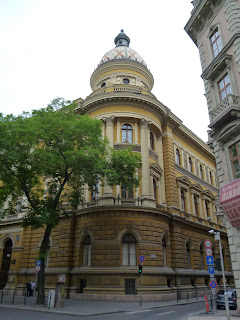Budapest's history like many great cities is marked by its statues. In Heroes Square, the great men of Hungary's long past stand sentinel looking towards Hungary's future.
Atop the tall pillar in the center is the Archangel Gabriel bringing the Hungarian(Magyar) people to their land. In his hand is the crown of St. Stephen.
And at the base of the pillar stands Arpad, who is sited as the founder of the Hungarian empire.

It is an impressive square. Originally, there were members of the Austrian Hapsburgs in the square, but after the fall of the Hapsburg dynasty, they were removed, and replaced by more Hungarian heroes.
Also present in the square were many statues celebrating the Soviet heroes that "freed" Hungary from the Nazis. Most have been removed and placed into Memento Park, which is just outside the city. The best way to visit it is to take the shuttle out. The shuttle price includes admission to the park, as well.
The park is full of large scale soviet era statues showing grateful Hungarians thanking their soviet saviors for rescuing them from the evil Nazis.

They also celebrate the great visionaries of the Soviet Union. Lenin, Marx, and Engels appear greeting you as you enter the park.
The statues are bold and emotional, and yet appear empty now and in some cases satirical.

At the far end of the park are two statues that appear to be
screaming warnings to stop before you hit the brick wall at the end of
the road. People often site this as a commentary on the end of
communism in Hungary. It ultimately proved to be a dead end.


Outside the park stands a parade ground rise upon which a statue of Stalin once stood. After the fall of the Soviet Union, the statue was torn down and destroyed. Stalin, like many dictators, is not well regarded by the people he controlled now that he is dead.

The Hungarians tread a fine tightrope in regards to the soviet monuments in that the soviets did liberate the Hungarian people from the Nazis, and many soviet soldiers gave their lives to do so, so there are still a few monuments and statues around town. There is a monument to the soviet soldiers who gave their lives. It still has a hammer and sickle on it.

In the same square, stands a statue of the American General H. H. Bandholtz, who is highly regarded by the Hungarians for preventing the removal of treasures from the National Museum by the Romanians.

Also not far from the Soviet monument stands a statue of Ronald Reagan,
who appears as pleased as the Hungarians regarding the collapse of the
Soviets control over Hungary.
There are many newer statues appearing in Hungary. Many of these are not about documenting Hungary's complicated political history, but are placed for fun. After all that Hungary has been through, I think it deserves a little fun.































































